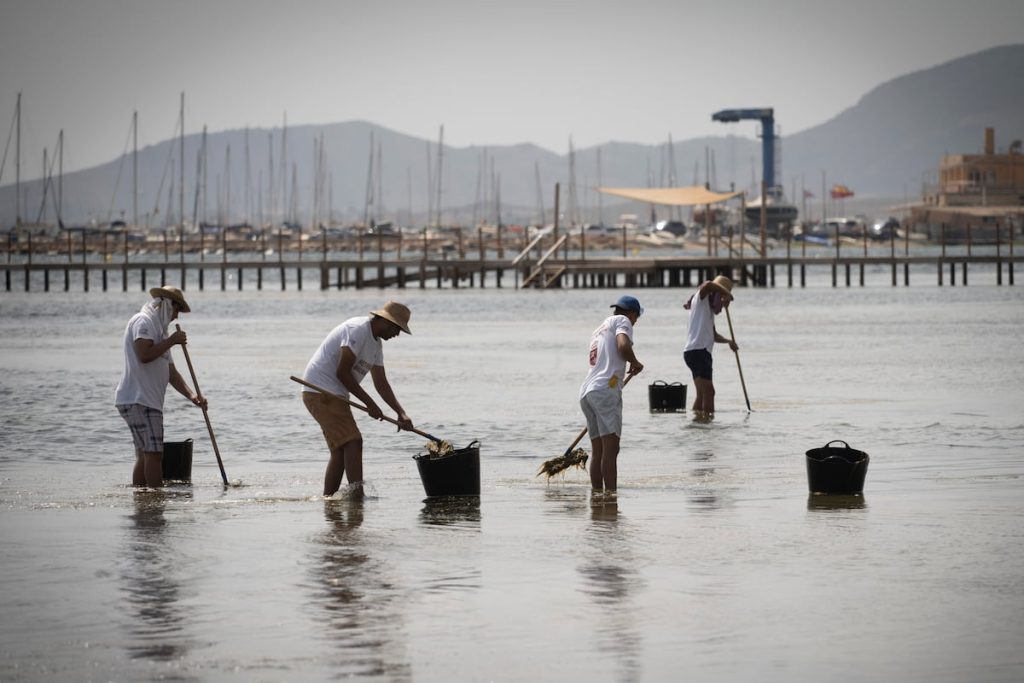The sun falls obliquely on the deserted beach. There are barely any children playing on the shore of Los Urrutias (Murcia), no sand buckets or rakes, just a mass of water ruined by man, from which two excavators remove piles of decomposing algae. The air is impregnated with each shovelful of an acidic smell that drives beachgoers away from the Mar Menor sea. Some observe the scene from the beach clubs, giant wooden walkways that allow bypassing the muck of the lagoon, where yellow foam also bubbles. This is the devastated postcard of a natural wonder threatened by uncontrolled urbanization and intensive agriculture. The degradation affects even the value of the real estate in the area, which has depreciated 4.8 billion euros in six years, as revealed by a study published recently in the journal Nature Scientific Report.
Directed by Gabriel Pérez Quirós, an economist at the Bank of Spain, the report analyzes the consequences of the environmental disaster on housing. It compares the average price per square meter in the beaches of Mar Menor (towns like Los Urrutias, Los Alcázares, or Los Nietos) with the southern coast of Alicante (Pilar de la Horadada, Dehesa de Campoamor, or La Zenia), once similar due to their proximity and construction quality. The real estate market studied began to detach from its Mediterranean parallel as the maladies affecting the Murcian lagoon became evident. The proliferation of harmful algae and phytoplankton led to episodes of anoxia – oxygen loss – resulting in thousands of dead fish. The origin of these phenomena lies in the high levels of nitrates in the water, coming mainly from irrigation in Campo de Cartagena (85%) and urban activities (15%), as detailed in the research.
“People are willing to pay less for an environment that is not as pleasant as before,” Pérez Quirós points out regarding a study co-authored with environmentalist Mari Luz García Lorenzo from the Complutense University. Based on cadastral data, the report excludes La Manga, affected only partially by this issue, as it also has access to the Mediterranean. The ailments of the Mar Menor are diverse. Intensive agriculture has led to contamination of the quaternary aquifer by nitrates, which then seep into the lagoon through the Albujón ravine – the orchard’s drainage – forming a river that carries chemicals. The effect of this infiltration is similar to fertilizing the sea, but instead of harvesting tomatoes, opportunistic algae and microplankton thrive. When this biomass dies, the easterly wind pushes it into the lagoon, significantly increasing the risk of anoxia if this sludge is not removed.
The cleaning brigades of the Murcian government extracted over 20 tons of organic waste last year alone. The collection gives rise to chilling scenes, like the one experienced this morning in Los Urrutias. “Do you think I would come to this beach if I didn’t have a house here?” asks Fuensanta Moreno (43 years) ironically, just before an excavator passes by her towel. This teacher from Cartagena is an example of what is called captive vacationers here. Her parents bought a two-story whitewashed house in the seventies for holidays. She recalls the feeling of eternal summer from that time. And the crystal-clear waters of the lagoon where seahorses trotted, sometimes wrapping around her fingers. The memory of what the Mar Menor used to be contrasts with its present state. “It’s very sad to come, but what can we do, sell the house cheaply and rent somewhere else? First of all, let’s see who would buy it.”
The devaluation of the real estate in this area also affects businesses. Their capacity largely depends on the value of their real estate assets, as the report highlights. “Obviously, we are worried about the future, ours and the town’s,” explains María José Gómez, who opened a language center in Los Alcázares with her partner over a decade ago, the only independent town in Mar Menor, along with San Javier, and heavily impacted by the dana. “Most of the politicians governing this community vacation in La Torre de la Horada, they do not know the Mar Menor. They also feel a deep disdain for the popular and democratic tourism that has traditionally characterized this area,” says the businesswoman. The possibility of a pact between the PP and Vox to govern the region worries her. “If the deniers enter the institutions, we are lost,” she adds. Just two kilometers from her academy, the Albujón ravine spews nitrate that poisons the largest saltwater lagoon on the continent.


